Home Care Business Plan Template & PDF Example

Creating a comprehensive business plan is crucial for launching and running a successful home care business. This plan serves as your roadmap, detailing your vision, operational strategies, and financial plan. It helps establish your home care business’s identity, navigate the competitive market, and secure funding for growth.
This article not only breaks down the critical components of a home care business business plan, but also provides an example of a business plan to help you craft your own.
Whether you’re an experienced entrepreneur or new to the healthcare industry, this guide, complete with a business plan example, lays the groundwork for turning your home care business concept into reality. Let’s dive in!
The Plan
Our Home Care business plan is designed to address all vital elements necessary for a detailed and effective operational strategy. This plan encompasses the scope of our home care services, marketing approaches, the environment in which we operate, an analysis of our competitors, the structure of our management team, and financial projections.
- Executive Summary: Offers a succinct overview of the Home Care business’s unique proposition, highlighting personalized and professional in-home care services tailored for seniors, market analysis showcasing the sector’s growth and demand, management’s expertise in senior care, and a financial strategy that outlines investment opportunities and revenue expectations.
- Business Overview: Provides an extensive look into the Home Care business’s operational model:
- Services & Area Coverage: Describes the array of in-home care services, including personal care, medication management, specialized care for dementia, and emergency response, all delivered within a specified service radius to meet the unique needs of each senior.
- Pricing: Details the pricing strategy, designed to be transparent and competitive, offering flexible options to cater to various financial situations of clients, including hourly and flat-rate packages tailored to different care needs.
- Market Overview: Explores the home care industry landscape, identifying key players and delineating the business’s distinctive position:
- Key Stats: Presents data underscoring the market size, growth trends, and demographics that illustrate the potential and necessity of home care services.
- Key Trends: Highlights significant trends such as the increasing preference for aging in place, the integration of technology in care, and a shift towards personalized care.
- Key Competitors: Analyzes the main competitors within the service area, their offerings, and how the business’s unique approach and technology set it apart.
- Strategy: Lays out the business’s strategic plan for growth and establishing a robust market presence:
- SWOT Analysis: Conducts a comprehensive analysis of Strengths, Weaknesses, Opportunities, and Threats to strategically position the business.
- Marketing Plan: Outlines marketing strategies aimed at building brand awareness, attracting new clients, and retaining them through superior service, patient satisfaction programs, and targeted marketing efforts.
- Timeline: Sets forth key milestones and objectives from the business setup to its launch and key growth phases.
- Management: Highlights the experienced team leading the business, from caregiving professionals to administrative management, emphasizing their roles in ensuring high-quality care and operational success.
- Financial Plan: Projects the financial outlook for the business over the next five years, detailing revenue models from various services, cost management strategies, profit margins, and expected return on investment, ensuring a clear route to financial sustainability and growth.

Executive Summary
The Executive Summary introduces your home care business plan, offering a concise overview of your agency and its services. It should detail your market positioning, the range of home care services you offer, including personal care, nursing care, and companion services, its service area, and an outline of day-to-day operations.
This section should also explore how your home care agency will integrate into the local community, including the number of direct competitors within the area, identifying who they are, along with your agency’s unique selling points that differentiate it from these competitors.
Furthermore, you should include information about the management and co-founding team, detailing their roles and contributions to the agency’s success. Additionally, a summary of your financial projections, including revenue and profits over the next five years, should be presented here to provide a clear picture of your agency’s financial plan.
Home Care Business Plan Executive Summary Example
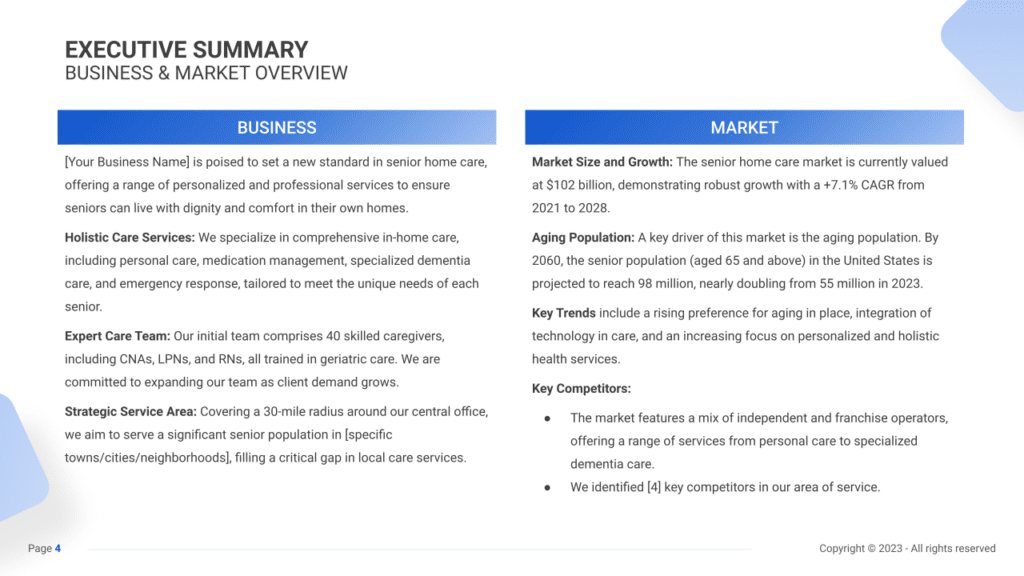
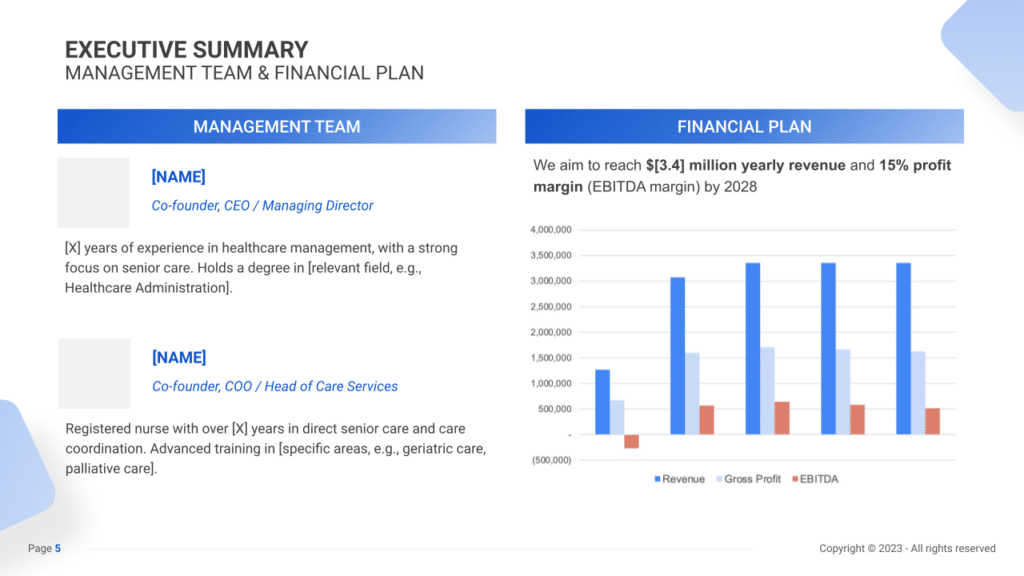
Business Overview
The business overview should succinctly define the unique aspects of your home care service, including specialized care offerings and the qualifications of your care team. Emphasizing what sets your business apart in the senior care market is key for drawing interest and investment.
Example:
“Compassionate Home Care,” covering a 30-mile radius in Springfield, offers personalized services such as medication management, specialized dementia care, and emergency response. The initial team of 40 skilled caregivers, including CNAs, LPNs, and RNs, are all trained in geriatric care, ensuring a high standard of service for seniors wishing to age comfortably in their homes.
Market Overview
This section should analyze the home care market’s size, growth trends, and competitive landscape. It positions your business within the industry and highlights its potential to meet the needs of an aging population.
Example:
Compassionate Home Care enters a market valued at $102 billion, growing at a 7.1% CAGR. Despite competition from four other local providers, the clinic stands out with its comprehensive, technology-integrated, and holistic approach to home care, meeting the rising preference for aging in place.
Management Team
Detailing the management team’s background and roles is vital. This part of the summary should emphasize their experience in healthcare and senior care, underscoring their ability to lead the business successfully.
Example:
The CEO, with extensive experience in healthcare management, leads the business strategy and operations, while the COO, a registered nurse with specialized training in geriatric and palliative care, heads the care services. Their combined expertise ensures a strong foundation for the business and high-quality care for clients.
Financial Plan
Clearly outlining financial goals and projections is key. This section should include revenue targets and profit margins, offering insight into the business’s financial health and growth potential.
Example:
Compassionate Home Care aims to achieve $3.4 million in annual revenue with a 15% profit margin by 2028. Supported by a robust business model and strategic marketing efforts, the company is positioned for significant growth in the expanding senior home care market.
Business Overview
For a Home Care Business, the Business Overview section can be effectively divided into 2 main slides:
Services & Area Coverage
Briefly describe the range of home care services your agency offers, emphasizing the personalized and compassionate care provided to clients in the comfort of their own homes. This can include personal care services like bathing and dressing, skilled nursing care, physical therapy, and companion services such as meal preparation and light housekeeping.
Then, mention the geographic area your agency covers, highlighting the convenience and accessibility of your services to clients within this area. Explain why your service area is strategically chosen to meet the needs of your target clientele, considering factors like population demographics and the presence of community resources.
Pricing & Payment Options
Detail your pricing structure for the various home care services offered, ensuring it reflects the quality of care provided and is competitive within the market you’re targeting. Your pricing strategy should be transparent, making it easy for clients and their families to understand the cost of care.
Also,highlight any flexible payment options, insurance partnerships, or programs that can help offset the cost for clients, such as Medicaid, Medicare, or private insurance coverage. Emphasize any packages or special programs that provide added value to your clients, such as customized care plans or discounted rates for long-term services, encouraging long-term relationships and client loyalty.
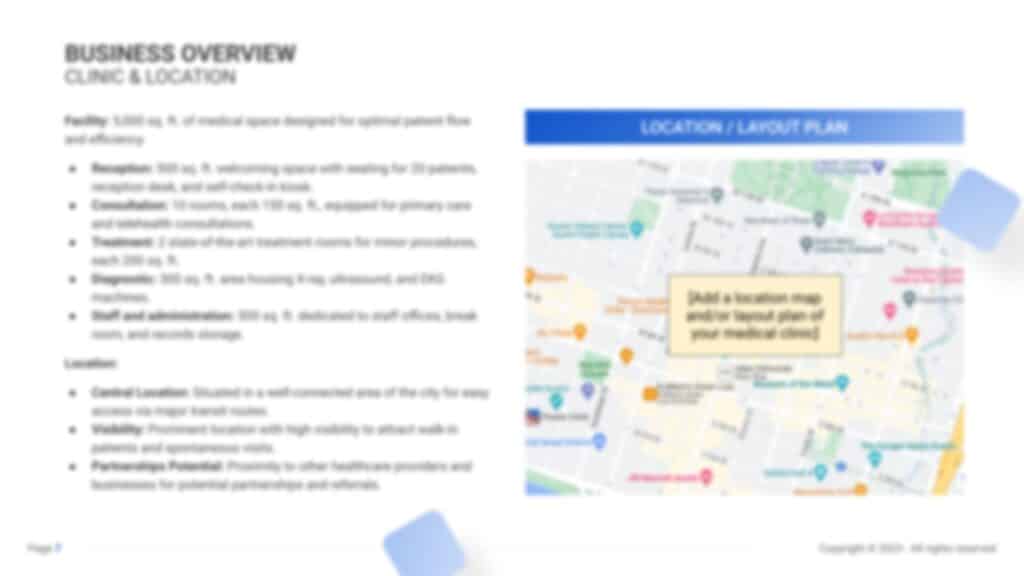
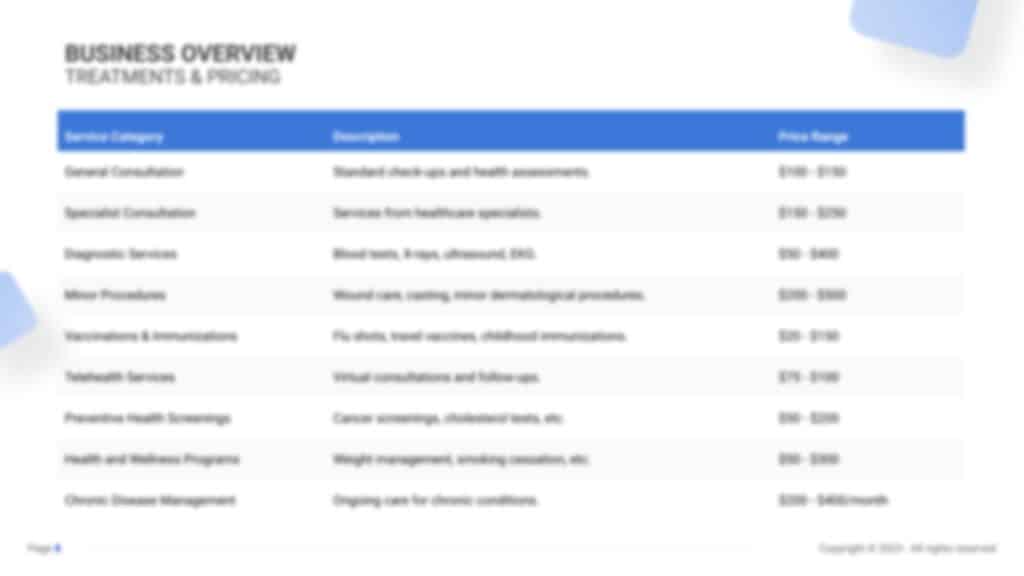
Market Overview

Industry size & growth
In the Market Overview of your home care business plan, start by examining the size of the home care industry and its growth potential.
This analysis is crucial for understanding the market’s scope and identifying expansion opportunities, particularly in the context of an aging population and increasing preference for aging in place.
Key market trends
Proceed to discuss recent market trends, such as the growing consumer interest in personalized home care services, the use of technology to improve service delivery, and the emphasis on holistic care that encompasses physical, emotional, and social well-being.
For example, highlight the demand for services tailored to specific health conditions or preferences, alongside the rising popularity of integrated care models that coordinate across different healthcare providers.
Competitive Landscape
A competitive analysis is not just a tool for gauging the position of your home care business in the market and its key competitors; it’s also a fundamental component of your business plan.
This analysis helps in identifying your home care’s unique selling points, essential for differentiating your business in a competitive market.
In addition, competitive analysis is integral in laying a solid foundation for your business plan. By examining various operational aspects of your competitors, you gain valuable information that ensures your business plan is robust, informed, and tailored to succeed in the current market environment.
Identifying Competitors in the Home Care Sector
Begin by mapping out local home care service providers, including agencies specializing in elderly care, disability assistance, and in-home nursing care. Don’t limit your assessment to direct competitors alone; consider indirect competitors like assisted living facilities or telehealth services that may offer alternative solutions to potential clients.
Leverage online resources such as industry directories, healthcare platforms, and review sites like Healthgrades or Care.com to identify competitors and assess their service offerings, customer reviews, and ratings. For instance, positive feedback highlighting the compassionate care at “Caring Hands Home Health” signifies a strength you might want to factor into your analysis.
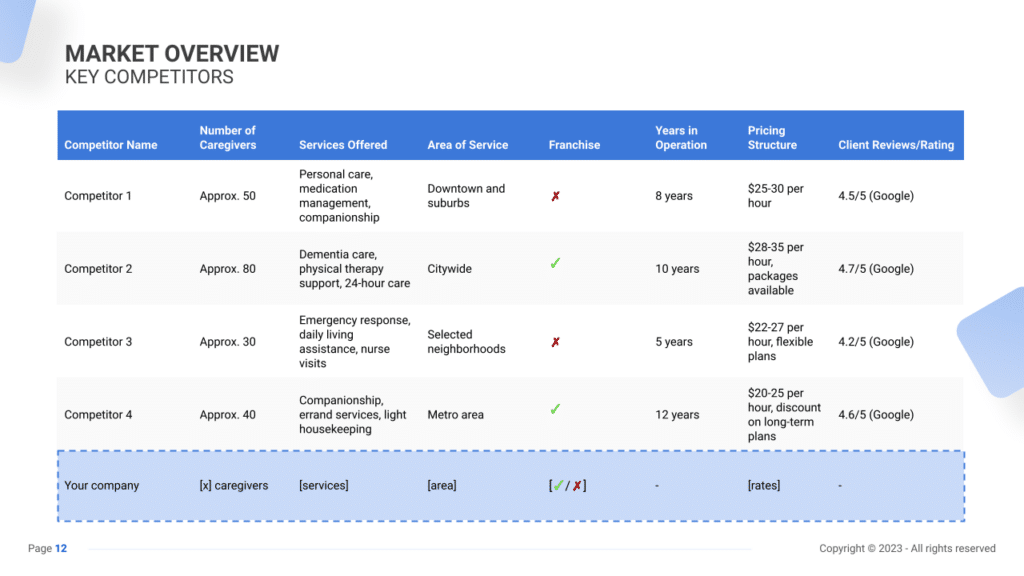
Home Care Competitors’ Strategies
Delve into multiple facets when analyzing competitors in the homecare industry:
- Service Offerings: Scrutinize the spectrum of services provided by competitors. If “Nurturing Hearts Senior Care” is gaining traction by offering specialized memory care services for seniors with dementia, this reflects an emerging trend or niche within the market.
- Care Approaches: Consider different caregiving approaches. A home care agency like “Comfort at Home Nursing” that emphasizes holistic care might cater to a different clientele compared to “Rapid Recovery Home Services,” known for its post-surgery rehabilitation programs.
- Pricing and Payment Models: Compare the pricing structures of competitors. Are they positioning themselves as budget-friendly, like “Economical Care Services,” or do they offer premium services like “Elite Home Health” with concierge-level care?
- Marketing Channels: Examine competitors’ marketing strategies. Are they leveraging digital platforms effectively, emphasizing community engagement, or relying on partnerships with healthcare providers to expand their reach?
- Client Experience: Evaluate the overall client experience. For instance, “Warm Embrace Home Care” might be recognized for its compassionate caregivers and personalized attention, fostering a positive client experience.
- Operational Innovations: Look for technological advancements or operational efficiencies adopted by competitors, such as “TechCare Solutions” utilizing telemedicine or streamlined scheduling systems for enhanced service delivery.
What’s Your Home Care Business’s Value Proposition
Define your home care agency’s unique value proposition. Perhaps your agency specializes in personalized Alzheimer’s care or provides bilingual caregivers, catering to a specific demographic overlooked by competitors.
Identify untapped market needs through client feedback and industry trends. For instance, the increasing demand for tech-integrated remote monitoring might present an opportunity if competitors haven’t embraced such solutions.
Tailor your services to suit the demographics and preferences of your target area. A home care agency in an urban setting might emphasize on-demand services and tech-enabled communication, while one in a suburban locale may focus on building community connections and personalized care plans.
Strategy

SWOT
First, conduct a SWOT analysis for the home care business, highlighting Strengths (such as compassionate and well-trained caregivers, a comprehensive range of services), Weaknesses (including potential regulatory challenges or staffing issues), Opportunities (for example, an aging population and increasing preference for home-based care), and Threats (such as changes in healthcare policies that may affect funding or reimbursement).

Marketing Plan
Next, develop a marketing strategy that outlines how to attract and retain clients through targeted outreach, informative and empathetic communication, engaging online presence, and community partnerships. Emphasize the importance of building trust with clients and their families, showcasing testimonials, and highlighting the qualifications and dedication of your caregiving team.
Marketing Channels
Deploying various marketing channels is pivotal to reaching and engaging with potential clients effectively.
Digital Marketing
- Website and SEO: Develop a user-friendly website with informative content about services offered, testimonials, and a blog providing caregiving tips. Optimize it for local SEO to enhance visibility in online searches.
- Social Media: Utilize platforms like Facebook and LinkedIn to share engaging content, client testimonials, and educational resources on home care. Use Instagram to showcase the compassionate side of your caregivers and their impact.
Local Advertising
- Community Engagement: Engage with local communities through sponsorships of senior events, health fairs, or support groups. Host informational sessions or workshops on home care topics at community centers or retirement communities.
Partnerships and Referral Programs
- Healthcare Partnerships: Forge alliances with hospitals, rehabilitation centers, or medical professionals for referrals. Establish yourself as a trusted partner in providing post-hospitalization or long-term care.
- Referral Programs: Create incentives for existing clients or healthcare providers who refer new clients to your home care services.
Promotional Activities
- Free Consultations: Offer complimentary consultations to potential clients, allowing them to experience the quality of your services firsthand.
- Special Offers: Introduce introductory packages or discounts for new clients or seasonal promotions like ‘Holiday Care Packages’ to attract new business.

Sales Channels
Efficient sales channels are imperative for maximizing revenue while ensuring customer satisfaction in the home care sector.
Consultative Selling
- Tailored Care Plans: Customize care plans based on the client’s needs and preferences during initial consultations. Emphasize the personalization and flexibility of your services.
- Transparent Pricing: Clearly outline pricing structures for different care plans, ensuring transparency and clarity for potential clients.
Client Retention Strategies
- Quality Service: Ensuring consistent and high-quality service delivery through ongoing caregiver training, quality checks, and client feedback mechanisms to guarantee satisfaction.
- Feedback Mechanisms: Use membership programs as an avenue to gather feedback from clients. Offer surveys or feedback forms to understand their preferences better and continuously improve services.
- Continued Engagement: Maintaining regular communication through newsletters, informative resources, health updates, and follow-up calls or visits to strengthen relationships and foster trust and loyalty.
Membership and Loyalty Programs
Incentivizing repeat business through membership and loyalty programs is a powerful strategy to foster long-term client relationships and encourage ongoing engagement.
Membership Options
- Exclusive Service Bundles: Offer membership programs providing clients with a set number of hours of care or specific services at a discounted rate. For instance, a monthly membership could include a predetermined number of hours for companion care, personal care, or specialized medical assistance.
- Customizable Plans: Create tiered membership levels with varying benefits to accommodate different client needs. These could range from basic caregiving services to more comprehensive care plans, providing flexibility and value to clients.
Loyalty Rewards
- Point-Based System: Develop a digital loyalty program where clients earn points for every dollar spent on home care services. These points can be accumulated and redeemed for discounts on future services or additional perks, such as priority scheduling or complimentary consultations.
- Referral Incentives: Reward clients for referrals by offering bonus points or discounts when they refer friends or family members to the home care services. This not only encourages loyalty but also helps expand the client base through word-of-mouth referrals.
Exclusive Benefits
- Member-Only Offers: Provide exclusive offers or special benefits to members, such as priority access to caregivers, discounted rates on additional services, or access to educational resources and workshops related to caregiving.
- Anniversary Rewards: Celebrate client milestones, such as membership anniversaries, with bonus points, complimentary service upgrades, or personalized gifts to showcase appreciation and reinforce client loyalty.
Strategy Timeline
Finally, create a detailed timeline that outlines critical milestones for the home care agency’s launch, client acquisition efforts, service expansion, and strategic objectives, ensuring the business advances with clear direction and purpose. Include key benchmarks for assessing the quality of care, client satisfaction, and operational efficiency to continually improve and grow your agency.

Management
The Management section focuses on the home care business’s management and their direct roles in daily operations and strategic direction. This part is crucial for understanding who is responsible for making key decisions and driving the home care business towards its financial and operational goals.
For your home care business plan, list the core team members, their specific responsibilities, and how their expertise supports the business.


Financial Plan
The Financial Plan section is a comprehensive analysis of your financial projections for revenue, expenses, and profitability. It lays out your home care business’s approach to securing funding, managing cash flow, and achieving breakeven.
This section typically includes detailed forecasts for the first 5 years of operation, highlighting expected revenue, operating costs and capital expenditures.
For your home care business plan, provide a snapshot of your financial statement (profit and loss, balance sheet, cash flow statement), as well as your key assumptions (e.g. number of customers and prices, expenses, etc.).
Make sure to cover here
_ Profit and Loss
_ Cash Flow Statement
_ Balance Sheet
_ Use of Funds









